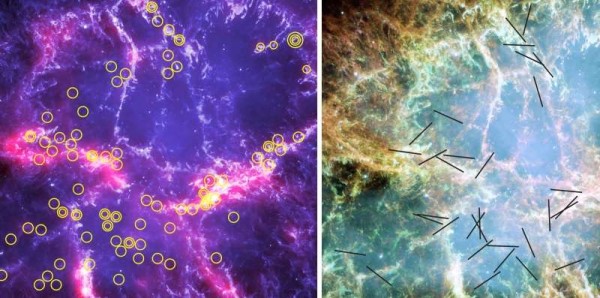Recently, a team of scientists led by Tiia Grenman of the Luleå University of Technology in Sweden has analyzed broadband images of the Crab Nebula acquired by the Hubble Space Telescope (HST) between 1994 and 2014. They were looking for dusty clumps like the ones surrounding young stellar clusters.
"The background to this work is our surveys of globulettes in H II regions surrounding young stellar clusters. We were surprised to find similar dusty clumps in the Crab and wondered about similarities and different origins. Rather soon, we found from HST images that the objects were moving with high speed in line with the general expansion of the Crab," said Gösta Gahm of the Stockholm Observatory in Sweden, one of the co-authors of the paper, speaking to Phys.org.
By analyzing the set of HST images, the team managed to locate 92 dusty globules and derived a wealth of data about their properties, including their dimensions, masses, proper motions and distributions.
According to the paper, mean radii of these globules ranges from 400 to 2,000 AU and about 40 percent of the them are slightly elongated with a ratio between major and minor axes higher than 1.5. Their masses vary from one to 58 millionths of the mass of the sun. The researchers found that the globules are distributed over the entire nebula but are less abundant in the region surrounding the central pulsar. They also noted that all the globules move outward from the center along with the general expansion of the remnant.
Read more at: http://phys.org/news/2016-11-scientists-dusty-globules-crab-nebula.html#jCp
Recently, a team of scientists led by Tiia Grenman of the Luleå University of Technology in Sweden has analyzed broadband images of the Crab Nebula acquired by the Hubble Space Telescope (HST) between 1994 and 2014. They were looking for dusty clumps like the ones surrounding young stellar clusters.
"The background to this work is our surveys of globulettes in H II regions surrounding young stellar clusters. We were surprised to find similar dusty clumps in the Crab and wondered about similarities and different origins. Rather soon, we found from HST images that the objects were moving with high speed in line with the general expansion of the Crab," said Gösta Gahm of the Stockholm Observatory in Sweden, one of the co-authors of the paper, speaking to Phys.org.
By analyzing the set of HST images, the team managed to locate 92 dusty globules and derived a wealth of data about their properties, including their dimensions, masses, proper motions and distributions.
According to the paper, mean radii of these globules ranges from 400 to 2,000 AU and about 40 percent of the them are slightly elongated with a ratio between major and minor axes higher than 1.5. Their masses vary from one to 58 millionths of the mass of the sun. The researchers found that the globules are distributed over the entire nebula but are less abundant in the region surrounding the central pulsar. They also noted that all the globules move outward from the center along with the general expansion of the remnant.
Read more at: http://phys.org/news/2016-11-scientists-dusty-globules-crab-nebula.html#jCp
ESO-studie av "Förödelsens pelare"
Spektakulära nya observationer av de enorma pelarliknande strukturerna inuti Carinanebulosan har gjorts med hjälp av instrumentet MUSE som sitter på ESO:s Very Large Telescope. De olika pelarna, som analyserades av ett internationellt forskarlag, ser ut att vara pelare fyllda med förödelse – i kontrast till namnet som de ikoniska Skapelsens pelare har i Örnnebulosan, som också är en liknande miljö.
Bildkälla: ESO/A McLeod
Spirorna och pelarna i de nya bilderna av Carinanebulosan är väldiga moln av stoft och gas inuti ett nav för stjärnbildning ungefär 7500 ljusår bort. Pelarna i nebulosan observerades av ett forskarlag som leds av Anna McLeod, doktorand vid ESO, och som använde instrumentet MUSE vid ESO:s Very Large Telescope.
Vad som gör MUSE så kraftfullt är att det samtidigt skapar tusentals bilder av nebulosan, var och en i olika våglängdsintervaller. Detta gör det möjligt för astronomer att kartlägga de kemiska och fysiska egenskaperna hos materialet från olika delar av nebulosan.
Ironiskt nog är en av de första konsekvenserna från bildandet av massiva stjärnor att de börjar förstöra molnet från vilket de föddes. Idén att massiva stjärnor har en sådan betydande effekt på deras omgivning är inte något nytt: man vet att sådana stjärnor kastar ut enorma mängder av kraftfull, joniserande strålning – emission med tillräckligt med energi för att tömma atomer på deras omgivande elektroner. Men det är väldigt svårt att samla in observationella bevis på samspelet mellan dessa stjärnor och deras omgivning.
Bildkälla: ESO/A McLeod
Forskarlaget analyserade effekterna som denna energiska strålning har på pelarna: en process som på engelska kallas photoevaporation (ljusförångning), när gasen joniseras och sedan förskingras. Genom att observera resultaten av ljusförångning – vilket inkluderar pelarnas förlust av massa – kunde forskarna hitta orsaken. De hittade ett tydligt samband mellan mängden av joniserad strålning som sändes ut av de närliggande stjärnorna och hur pelarna förskingras.
Detta kan tyckas vara en kosmisk katastrof, där massiva stjärnor vänder sig emot sina skapare. Men komplexiteten i återkopplingsmekanismerna mellan stjärnorna och pelarna är fortfarande inte välförstådd. Dessa pelare kan se ut att vara tätpackade, men molnen av stoft och gas som tillsammans utgör nebulosan är faktiskt väldigt tunna. Det är möjligt att strålning och stjärnvindarna från de massiva stjärnorna faktiskt skapar mer tätpackade platser inuti pelarna, där stjärnor eventuellt kan bildas.
Nästan hundra globuler upptäckta i Krabban
Krabbnebulosan är ett tacksamt himaobjekt att skriva om, och det är EXTRA tacksamt när svenska forskare är på banan – som nu trion Tiia Grenman, Gösta Gahm och Erik Elfgren, som identifierat inte mindre än 92 väldefinierade, mörka globuler i nebulositeten. Huvudsakligen genom att studera HST-bilder genom åren 1994-2014.
Vi ska återkomma till rapporten, men här finns den ("Dusty Globules in the Crab Nebula"):
https://arxiv.org/pdf/1610.08449.pdf
Jag gillar vännen Göstas kommentar på Phys.org-sajten:
– Cold dust in supernova remnants is a hot subject…
Read more at: http://phys.org/news/2016-11-scientists-dusty-globules-crab-nebula.html#jCp
Recently, a team of scientists led by Tiia Grenman of the Luleå University of Technology in Sweden has analyzed broadband images of the Crab Nebula acquired by the Hubble Space Telescope (HST) between 1994 and 2014. They were looking for dusty clumps like the ones surrounding young stellar clusters.
"The background to this work is our surveys of globulettes in H II regions surrounding young stellar clusters. We were surprised to find similar dusty clumps in the Crab and wondered about similarities and different origins. Rather soon, we found from HST images that the objects were moving with high speed in line with the general expansion of the Crab," said Gösta Gahm of the Stockholm Observatory in Sweden, one of the co-authors of the paper, speaking to Phys.org.
By analyzing the set of HST images, the team managed to locate 92 dusty globules and derived a wealth of data about their properties, including their dimensions, masses, proper motions and distributions.
According to the paper, mean radii of these globules ranges from 400 to 2,000 AU and about 40 percent of the them are slightly elongated with a ratio between major and minor axes higher than 1.5. Their masses vary from one to 58 millionths of the mass of the sun. The researchers found that the globules are distributed over the entire nebula but are less abundant in the region surrounding the central pulsar. They also noted that all the globules move outward from the center along with the general expansion of the remnant.
Read more at: http://phys.org/news/2016-11-scientists-dusty-globules-crab-nebula.html#jCp
Recently, a team of scientists led by Tiia Grenman of the Luleå University of Technology in Sweden has analyzed broadband images of the Crab Nebula acquired by the Hubble Space Telescope (HST) between 1994 and 2014. They were looking for dusty clumps like the ones surrounding young stellar clusters.
"The background to this work is our surveys of globulettes in H II regions surrounding young stellar clusters. We were surprised to find similar dusty clumps in the Crab and wondered about similarities and different origins. Rather soon, we found from HST images that the objects were moving with high speed in line with the general expansion of the Crab," said Gösta Gahm of the Stockholm Observatory in Sweden, one of the co-authors of the paper, speaking to Phys.org.
By analyzing the set of HST images, the team managed to locate 92 dusty globules and derived a wealth of data about their properties, including their dimensions, masses, proper motions and distributions.
According to the paper, mean radii of these globules ranges from 400 to 2,000 AU and about 40 percent of the them are slightly elongated with a ratio between major and minor axes higher than 1.5. Their masses vary from one to 58 millionths of the mass of the sun. The researchers found that the globules are distributed over the entire nebula but are less abundant in the region surrounding the central pulsar. They also noted that all the globules move outward from the center along with the general expansion of the remnant.
Read more at: http://phys.org/news/2016-11-scientists-dusty-globules-crab-nebula.html#jCp
Read more at: http://phys.org/news/2016-11-scientists-dusty-globules-crab-nebula.html#jCp
Read more at: http://phys.org/news/2016-11-scientists-dusty-globules-crab-nebula.html#jCp
T v globulernas placering i nebulosan, t h visas läget för de mera utsträckta avlånga stoftrika globulerna. Bildkällor: Vänsterbilden HST, Herschel Space Observatory, ESA, NASA, högerbilden HST, ESA, NASA
Några fakta:
* Globulernas radier rör sig i spannet 400-2000 AU, alltså astronomiska enheter (1 AU = medelavståndet jorden-solen).
* Samtliga globuler rör sig utåt från centrumet med en hastighet av 60-1600 km/s.
Novorna bakar litium
En ny rapport visar att litium, grundämnet, skapas av novor. En stjärnsmäll i Sagittarius/Skytten 2015 visar hur sönderfallet av beryllium-7 gått över i stabilt litium.
Read more at: http://phys.org/news/2016-11-stellar-novae-main-source-lithium.html#jCp
Read more at: http://phys.org/news/2016-11-stellar-novae-main-source-lithium.html#jCp
Märklig stjärnbana
Ett binärt system med en vit dvärg och en millisekundpulsar i en bana med oväntat hög banexentricitet – kan det vara något? Svaret här.
Gammelstjärna hittad
När en stjärna har lite järn i sin atmosfär är det en markör på ålder – hög ålder!
Nu har ytterligare ett system hittats med ett järn/väte-förhållande på nästan -5, vilket ger en ålder på runt 13 miljarder år.
Solen ställer till det
Tack till mästerfotografen Claes Westlin, som från hemmet i Beddingestrand följer naturskådespelet med solens nedgångar. Då kan resultatet bli förödande vackert ut mot havet som följer – det är fotorealism i ordets konkreta mening:
Där horisonten är vid är det inga problem att reda ut vad som är vad, men inne i stan kan de spektakulära solnedgångarna ställa till det. Husen skymmer och plötsligt löper fantasin i väg. Lars Olefeldt noterar följande "fynd" på nätet:




